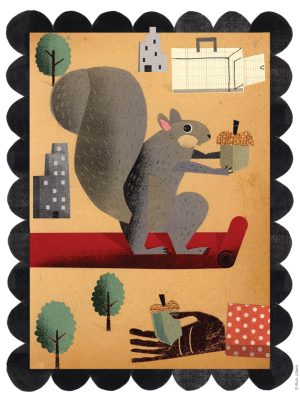
Cockroaches may inspire greater revulsion and mice may drive more people mad, but when it comes to roof-chewing, wire-gnawing, attic-wrecking havoc, an urban homeowner has few costlier guests than the eastern gray squirrel. And if you’ve ever unwillingly hosted one between your roof and the ceiling, you may have wondered: Why are these forest creatures in the city to begin with?
Because Philadelphians decided to roll out the red carpet for the bushy-tailed rodents in the 19th century—and other cities hopped on the squirrel-loving bandwagon. That’s according to Etienne Benson, an assistant professor of the history and sociology of science, who spoke with Gazette associate editor (and confessed squirrel antagonist) Trey Popp about the surprising history of Americans’ relationship with Sciurus carolinensis in January. Benson’s research appeared in the December issue of the Journal of American History.
When did Philadelphians introduce squirrels into the city?
People had kept squirrels as pets for a long time, since at least the 18th century. So in that sense there were probably a few squirrels in cities—but they were pets in people’s homes in cages. It was only in the 1840s that people thought they could beautify parks and public spaces in cities by having these free-living animals in them. Philly didn’t only introduce squirrels; it also introduced peacocks, and even had some caged deer in at least one of the parks, in a little paddock. So squirrels weren’t the only animals being released, but they were the most successful—from the squirrels’ point of view.
Why did people suddenly decide they wanted bushy-tailed neighbors?
Part of it was a changing idea of what public spaces in the city were for—that they should be more public, and more leisure-oriented. A great example is Boston, which followed Philly’s example in about 1854, and released squirrels on the Boston Common. The Boston Common had been a public space for a very long time. But it had been used for a lot of different things: as a rallying space, for military exercises, to pasture cows, as a place to hang people, and for various economic activities as well. So it was a very well-used space, but not somewhere you’d imagine going with a book and sitting on a bench and watching the people walk by. In the middle of the 19th century, it started getting turned into a park, a place for leisure.
Part of the idea was just making it nicer for people who lived downtown. But there was also lots of ideology built into that—like the importance of having access to nature or pastoral scenes in the heart of the city, for working people and immigrants who might not be able to get outside of the city by going off to their country estate. And I think that was an important part of the reason for introducing squirrels, which were associated with the countryside and the deep woods.
What changed about American cities that allowed squirrels to begin thriving in them? And why hadn’t they just come in from the countryside on their own?
Why weren’t there squirrels in America’s cities? Well, they were getting shot. Around the outsides of cities you might have orchards and vegetable gardens, and of course the squirrels would try to eat that stuff. So they’d get shot. They’d also get shot because people ate them. So not shooting them anymore was crucial.
Philadelphia and other cities also began intentionally feeding squirrels—buying a bunch of peanuts and handing them out, especially over the winter. Judging from the amount of effort that was put into feeding them, it seems like they must have been pretty dependent on handouts at first.
And transforming the landscape of the city was also part of it. The core areas of American cities didn’t have a lot of trees, greenery, or parks. And that started to change in the middle of the 19th century. People started planting street trees. As cities grew, they reserved areas as parks—where squirrels could run and hide.
Sometimes ecologists talk about squirrels—or crows or starlings or pigeons—as “weed species” that automatically flourish in human-disturbed environments. One of the things this history shows is that there are a lot of human choices that get made about how humans are going to act toward animals and shape the urban environment.
When and why did American city-dwellers stop feeding squirrels?
By the 1960s and ’70s, environmentalists and biologists started criticizing feeding them. There were efforts to actually criminalize feeding—with park regulations and signs prohibiting the feeding of wildlife. A great example of why this happened was Lafayette Square in Washington, DC, which at some point was ascertained to have the densest population of gray squirrels anywhere in the world. They were getting fed constantly by tourists, and also by some very devoted feeders who lived in DC. The Park Service cracked down on that, and even tried to cull the population—which led to an outcry from animal-rights activists, and so forth.
On the one hand, there were longstanding concerns about the damage that these animals do if their numbers get too high—eating bark, digging up gardens, and that sort of stuff. And on the other hand, there was an increasing sense that it was actually bad for the squirrels themselves to be fed. People talked about this Lafayette Square population being sickly and mangy and undernourished. So there was some sense that even though these animals lived in the city, they should be allowed to live an independent, natural life. And a crucial side to that is not having them be dependent on human feeding anymore.
All the people who worried about the squirrel populations dying out if they weren’t being fed obviously turned out to be wrong.

